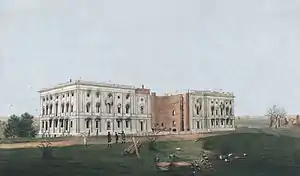Ротонда Капитолия США
Ротонда Капитолия США (англ. United States Capitol rotunda) — центральная ротонда вашингтонского Капитолия в округе Колумбия, США. Расположена под массивным куполом Капитолия. Помещение задумывалось как «символическое и физическое сердце» здания.
| Достопримечательность | |
| Ротонда Капитолия США | |
|---|---|
 | |
| 38°53′24″ с. ш. 77°00′36″ з. д. | |
| Страна | |
| Местоположение | Вашингтон |
Ротонда окружена сетью коридоров, соединяющих половину Капитолия, занимаемую Палатой представителей, с половиной, относящейся к Сенату. К югу расположен полукруглый Национальный скульптурный зал, в котором до 1859 года заседала Палата представителей. С севера к ротонде прилегает Старый кабинет Сената, где последний проводил заседания до 1857 года.
Диаметр ротонды — 29 метров, высота до потолка — около 55 метров. Помещение весьма популярно среди туристов. Помимо всего прочего, в ротонде проводятся официальные мероприятия вплоть до публичных прощаний с известными людьми, в том числе с президентами США.
Архитектура
В 1793 году прошёл конкурс на лучший дизайн для Капитолия. Победителем стал американский врач и архитектор Вильям Торнтон. Ему и принадлежала идея построить в Капитолии ротонду. Однако из-за нехватки средств и ресурсов, а также из-за британского нападения на Вашингтон во время Англо-американской войны 1812 года, замысел зодчего не был воплощён. Работы над зданием продолжились лишь в 1818 году.
Строительство ротонды закончилось в 1824 под руководством архитектора Капитолия Чарльза Балфинча к визиту французского революционера Мари-Жозеф Лафайета. В то время купол и ротонда, как и весь Капитолий, были построены в неоклассическом стиле и напоминали римский Пантеон.
 Чарльз Балфинч
Чарльз Балфинч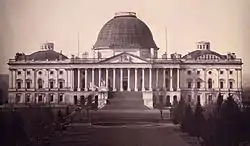 Капитолий к 1846 году
Капитолий к 1846 году Купол Пантеона в Риме
Купол Пантеона в Риме
Высота сделанных из песчаника стен ротонды от пола — 15 метров (48 футов). Вскоре эта высота увеличилась. В 1854 году по инициативе четвёртого архитектора Капитолия Томаса Уолтера начались работы по надстройке здания. В частности началось возведение небывалого по тем временам купола. Также была расширена ротонда. Реконструкция велась по оригинальному проекту, разработанному Томасом. Согласно замыслам архитектора, над ротондой возводилось два купола: внутренний и внешний. Внешний запланировано было сделать завершённым, с колоннадой поперёк барабана. Внешний купол должен был напоминать купол Собора Святого Павла в Лондоне. У внутреннего же отсутствовала верхушка, образовывалась своеобразный проём в форме круга, чтобы через неё можно было видеть фреску, нанесённую на внутреннюю поверхность внешнего купола.
 Томас Уолтер
Томас Уолтер Двухслойный купол в разрезе
Двухслойный купол в разрезе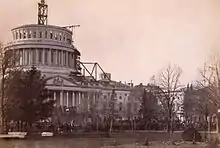 Надстройка ротонды в 1861
Надстройка ротонды в 1861
Томас Уолтер попросил исторического художника[1] Брумиди «нарисовать в том проёме картину 65 футов (20 метров) в диаметре, исполненную в виде фрески на вогнутом навесе глаза нового купола Капитолия США»
К 1859 году уже были готовы акварельные эскизы разных сцен будущей фрески. Купол Капитолия был готов к середине Гражданской войны. Каркас купола сконструирован из чугуна, что исключало пожары. Во время Гражданской войны ротонду приспособили под госпиталь союзных войск. Полностью работы по куполу завершились в 1866 году. После надстройки Капитолий стал напоминать уже парижский Пантеон.
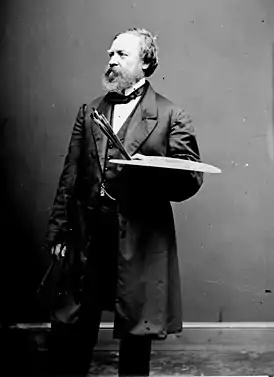 Константино Брумиди
Константино Брумиди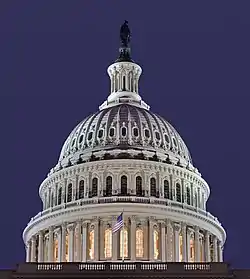 Новый купол Капитолия
Новый купол Капитолия Купол парижского Пантеона
Купол парижского Пантеона
Апофеоз Вашингтона
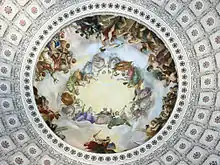
Фриз Американской истории
Барельефы
| Сцена | Описание |
|---|---|
 |
Америка и История англ. America and History На первом барельефе представлена аллегорическая сцена. На первом плане изображена Колумбия — олицетворение Америки с фригийским колпаком на голове, копьём и щитом в руках. Справа сидит, вооружённый луком и стрелами Индеец. Он представляет американскую землю. У ног Америки сидит аллегория Истории, записывающая на каменной плите события. Рядом с Историей на символизирующей власть фасции примостился Орёл. |
 |
Прибытие Колумба англ. Landing of Columbus Christopher Columbus is depicting arriving in the Americas in the first of four scenes of the Spanish conquest. Columbus disembarks off a plank from the Santa María. His crew, armed with weapons, stays aboard; one crew member has a spyglass. Native Americans are portrayed greeting Columbus. Indian women and children are shown, along with native warriors to the right. The Columbus figure may have been based on Luigi Persico statue of Columbus, which was at the time of the painting the on the east central steps of the Capitol. |
 |
Кортес и Монтесума в храме Ацтеков англ. Cortez and Montezuma at Mexican Temple This panel shows the Spanish conquistador Hernán Cortés entering an Aztec temple, being welcomed by Moctezuma II. At the beginning of the Spanish conquest of the Aztec Empire, Moctezuma and the Aztecs honored Cortés as a god, believing that he was the returning god Quetzalcoatl. The Aztec sun stone and cult images are based on sketches drawn by Brumidi in Mexico City. |
 |
Поход Писарро в Перу англ. Pizarro Going to Peru Spanish conquistador Francisco Pizarro is depicted leading his horse through the jungle in search of El Dorado, the mythical land of gold, in this representation of the Spanish conquest of the Inca Empire. |
 |
Похороны Десото англ. Burial of DeSoto This panel depict the burial of Spanish explorer Hernando de Soto in the Mississippi River after his death from a fever. De Soto has led the largest European expedition of both 15th and 16th centuries through the Southeast and Midwest searching for gold, silver, and other valuables. |
 |
Капитан Смит и Покахонтас англ. Captain Smith and Pocahontas Pocahontas is portrayed saving Captain John Smith, one of the founders of Jamestown, Virginia, from being clubbed to death. |
 |
Прибытие пилигримов англ. Landing of the Pilgrims Pilgrims led by William Brewster give thanks to God for their safe voyage in this scene depicting Plymouth Colony. |
 |
Вилльям Пенн и индейцы англ. William Penn and the Indians Quaker leader and Province of Pennsylvania founder William Penn is depicted with Lenape (Delaware) Native Americans under the elm tree at Shackamaxon. This is the last panel on which Brumidi worked. |
 |
Колонизация Новой Англии англ. Colonization of New England This panel shows New England settlers busily logging, sawing, and using lumber to construct a building. This is the first scene painted entirely by Costaggini. |
 |
Оглетроп и Индейцы англ. Oglethorpe and the Indians James Oglethorpe, founder of Georgia Colony and first Georgia governor, is shown with the Muskogee (Creek) leaders in Savannah, Georgia. The Muskogee present Oglethorpe with a buffalo skin with an eagle in the center, a symbol of friendship and trust. |
 |
Битва при Лексингтоне англ. Battle of Lexington This panel depicts the «shot heard 'round the world» at the Battle of Lexington, the first major battle of the American Revolutionary War. Major John Pitcairn is shown on horseback at center, with British Army or Royal Marines troops to the right and Lexington militiamen at left. |
 |
Декларация Независимости англ. Declaration of Independence Idealized depiction of John Adams, Thomas Jefferson, and Benjamin Franklin, authors of the Declaration of Independence, reading the declaration to celebrating colonists. |
 |
Сдача Корнуоллиса англ. Surrender of Cornwallis Depiction of George Washington on horseback receiving the ceremonial sword of surrender from Charles O'Hara, who represented Lord Cornwallis after the final British defeat at the Battle of Yorktown. In reality, it is thought that Washington declined O’Hara’s sword because according to the custom of the time it would only be proper for Washington to receive the sword from Cornwallis himself; Major General Benjamin Lincoln instead accepted the sword. |
 |
Гибель Текумсе англ. Death of Tecumseh This panel depicts the death of Shawnee chief and Indian Confederation leader Tecumseh at the Battle of the Thames in Upper Canada during the War of 1812 (partially an extension of Tecumseh's War). |
 |
Взятие Мехико американской армией англ. American Army Entering the City of Mexico U.S. Army troops led by Winfield Scott enter Mexico City after the fall of Mexico City, which ended the Mexican-American War with a decisive American victory. The 1848 Treaty of Guadalupe Hidalgo, which provided for the massive Mexican Cession of territory in what is now the Western United States. |
 |
Обнаружение золота в Калифорнии англ. Discovery of Gold in California Prospectors dig and pan for gold with picks, shovels, and other tools in this depiction of the California Gold Rush. In the center, three men (one possibly representing John Sutter) examine a prospector’s pan. This was the last scene designed by Brumidi and painted by Costaggini. |
 |
Мир и Конец Гражданской войны англ. Peace at the End of the Civil War This scene, the first of Allyn Cox’s three panels, depicts a Confederate soldier and a Union soldier shaking hands at the end of the American Civil War, symbolizing reconciliation and reunification. The cotton plant and the Northern pine tree symbolize the South and the North. |
 |
Орудие в Испано-Американской войне англ. Naval Gun Crew in the Spanish-American War A group of United States Navy sailors in a gun crew are depicted in a naval battle during the Spanish–American War. and the United States won a victory over Spain in the war. The 1898 Treaty of Paris provided for Cuba’s independence from Spain and the American acquisition of Puerto Rico, Guam, and the Philippines. |
 |
Рождение авиации англ. The Birth of Aviation This scene depicts the Wright brothers' first flight at Kitty Hawk in 1903. The Wright Flyer is shown just off the ground, with Orville Wright in the plane and Wilbur Wright running alongside to steady the wing. To the left are Leonardo da Vinci, Samuel Pierpont Langley, and Octave Chanute, other aviation pioneers, holding models of earlier designs for the first flying machine. An eagle holds an olive branch in the bottom right. |
Литература
- William C. Allen. History of the United States Capitol: A chronicle of design, construction, and politics. — Washington, D.C.: U.S. Government Printing Office, 2001.
Примечания
- Wolanin, Barbara A. Constantino Brumidi: artist of the Capitol (англ.). — Washington: U.S. Government Printing Office, 1998.

